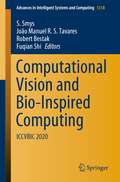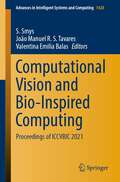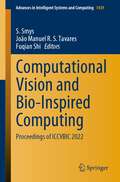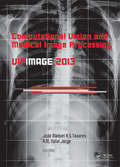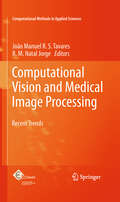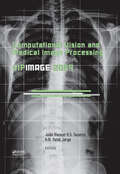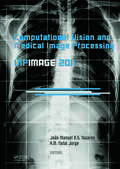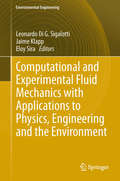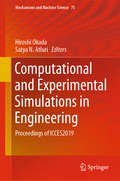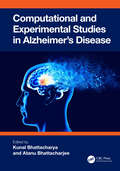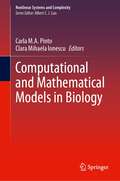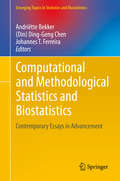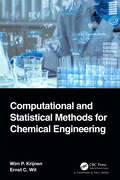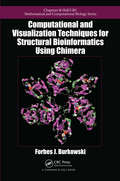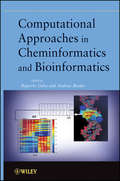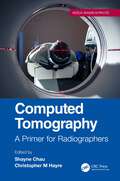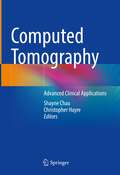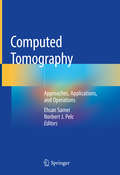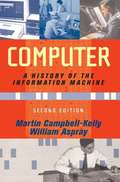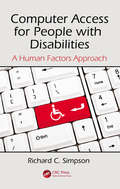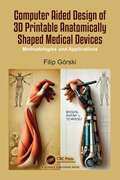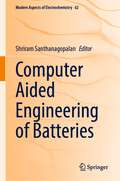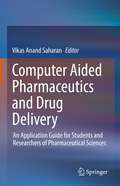- Table View
- List View
Computational Vision and Bio-Inspired Computing: ICCVBIC 2020 (Advances in Intelligent Systems and Computing #1318)
by João Manuel R. S. Tavares S. Smys Robert Bestak Fuqian ShiThis book includes selected papers from the 4th International Conference on Computational Vision and Bio Inspired Computing (ICCVBIC 2020), held in Coimbatore, India, from November 19 to 20, 2020. This proceedings book presents state-of-the-art research innovations in computational vision and bio-inspired techniques. The book reveals the theoretical and practical aspects of bio-inspired computing techniques, like machine learning, sensor-based models, evolutionary optimization and big data modeling and management that make use of effectual computing processes in the bio-inspired systems. As such it contributes to the novel research that focuses on developing bio-inspired computing solutions for various domains, such as human–computer interaction, image processing, sensor-based single processing, recommender systems and facial recognition, which play an indispensable part in smart agriculture, smart city, biomedical and business intelligence applications.
Computational Vision and Bio-Inspired Computing: Proceedings of ICCVBIC 2021 (Advances in Intelligent Systems and Computing #1420)
by João Manuel R. S. Tavares Valentina Emilia Balas S. SmysThis book includes selected papers from the 5th International Conference on Computational Vision and Bio Inspired Computing (ICCVBIC 2021), held in Coimbatore, India, during November 25–26, 2021. This book presents state-of-the-art research innovations in computational vision and bio-inspired techniques. The book reveals the theoretical and practical aspects of bio-inspired computing techniques, like machine learning, sensor-based models, evolutionary optimization and big data modeling and management that make use of effectual computing processes in the bio-inspired systems. It also contributes to the novel research that focuses on developing bio-inspired computing solutions for various domains, such as human–computer interaction, image processing, sensor-based single processing, recommender systems and facial recognition, which play an indispensable part in smart agriculture, smart city, biomedical and business intelligence applications.
Computational Vision and Bio-Inspired Computing: Proceedings of ICCVBIC 2022 (Advances in Intelligent Systems and Computing #1439)
by João Manuel R. S. Tavares S. Smys Fuqian ShiThis book includes selected papers from the 6th International Conference on Computational Vision and Bio Inspired Computing (ICCVBIC 2022), held in Coimbatore, India, from November 18 to 19, 2022. This volume presents state-of-the-art research innovations in computational vision and bio-inspired techniques. It includes theoretical and practical aspects of bio-inspired computing techniques, like machine learning, sensor-based models, evolutionary optimization and big data modeling and management that make use of effectual computing processes in the bio-inspired systems.
Computational Vision and Medical Image Processing IV: VIPIMAGE 2013
by João Manuel R.S. Tavares R.M. Natal JorgeComputational Vision and Medical Image Processing. VIPIMAGE 2013 contains invited lectures and full papers presented at VIPIMAGE 2013 - IV ECCOMAS Thematic Conference on Computational Vision and Medical Image Processing (Funchal, Madeira Island, Portugal, 14-16 October 2013). International contributions from 16 countries provide a comprehensive cov
Computational Vision and Medical Image Processing: Recent Trends (Computational Methods in Applied Sciences #19)
by Joao Tavares R. M. JorgeThis book contains extended versions of papers presented at the international Conference VIPIMAGE 2009 - ECCOMAS Thematic Conference on Computational Vision and Medical Image, that was held at Faculdade de Engenharia da Universidade do Porto, Portugal, from 14th to 16th of October 2009. This conference was the second ECCOMAS thematic conference on computational vision and medical image processing. It covered topics related to image processing and analysis, medical imaging and computational modelling and simulation, considering their multidisciplinary nature. The book collects the state-of-the-art research, methods and new trends on the subject of computational vision and medical image processing contributing to the development of these knowledge areas.
Computational Vision and Medical Image Processing: VipIMAGE 2009
by João Manuel R.S. Tavares & R.M. Natal JorgeComputational Vision and Medical Image Processing, VIPIMAGE 2009 contains the full papers presented at VIPIMAGE 2009 - Second ECCOMAS Thematic Conference on Computational Vision and Medical Image Processing, held in Porto, Portugal, on 14-16 October 2009. International contributions from twenty countries provide a comprehensive coverage of the curr
Computational Vision and Medical Image Processing: VipIMAGE 2011
by João Manuel R.S. Tavares R.M. Natal JorgeThis book contains invited lecturers and full papers presented at VIPIMAGE 2011 - III ECCOMAS Thematic Conference on Computational Vision and Medical Image Processing (Olh Algarve, Portugal, 12-14 October 2011). International contributions from 16 countries provide a comprehensive coverage of the current state-of-the-art in: Image Processing
Computational and Experimental Fluid Mechanics with Applications to Physics, Engineering and the Environment (Environmental Science and Engineering)
by Leonardo Di G. Sigalotti Jaime Klapp Eloy SiraThe book presents a collection of selected papers from the I Workshop of the Venezuelan Society of Fluid Mechanics held on Margarita Island, Venezuela from November 4 to 9, 2012. Written by experts in their respective fields, the contributions are organized into five parts: - Part I Invited Lectures, consisting of full-length technical papers on both computational and experimental fluid mechanics covering a wide range of topics from drops to multiphase and granular flows to astrophysical flows, - Part II Drops, Particles and Waves - Part III Multiphase and Multicomponent Flows - Part IV Atmospheric and Granular Flows - and Part V Turbulent and Astrophysical Flows. The book is intended for upper-level undergraduate and graduate students as well as for physicists, chemists and engineers teaching and working in the field of fluid mechanics and its applications. The contributions are the result of recent advances in theoretical and experimental research in fluid mechanics, encompassing both fundamentals as well as applications to fluid engineering design, including pipelines, turbines, flow separators, hydraulic systems and biological fluid elements, and to granular, environmental and astrophysical flows.
Computational and Experimental Simulations in Engineering: Proceedings of ICCES2019 (Mechanisms and Machine Science #75)
by Hiroshi Okada Satya N. AtluriThis book gathers the latest advances, innovations, and applications in the field of computational engineering, as presented by leading international researchers and engineers at the 24th International Conference on Computational & Experimental Engineering and Sciences (ICCES), held in Tokyo, Japan on March 25-28, 2019. ICCES covers all aspects of applied sciences and engineering: theoretical, analytical, computational, and experimental studies and solutions of problems in the physical, chemical, biological, mechanical, electrical, and mathematical sciences. As such, the book discusses highly diverse topics, including composites; bioengineering & biomechanics; geotechnical engineering; offshore & arctic engineering; multi-scale & multi-physics fluid engineering; structural integrity & longevity; materials design & simulation; and computer modeling methods in engineering. The contributions, which were selected by means of a rigorous international peer-review process, highlight numerous exciting ideas that will spur novel research directions and foster multidisciplinary collaborations.
Computational and Experimental Studies in Alzheimer's Disease
by Atanu Bhattacharjee Kunal BhattacharyaThis reference book compiles the recent advances in computational and experimental modelling to screen and manage Alzheimer’s disease. It covers basic etiopathology and various in vitro and in vivo strategies of disease intervention. The book discusses how computer-aided drug design approaches reduce costs and increase biological test efficiency. It reviews the screening for anti-Alzheimer drugs and biomarker analysis of disease inhibitors. The book also explores mechanistic aspects of neurodegeneration and the use of natural products as therapeutics for Alzheimer’s disease.Key features: Elaborates on the computational modelling of protein target inhibitors as anti-Alzheimer’s agents Explains the role of phytomolecules and natural products in Alzheimer’s therapy Reviews preclinical ways to assess drugs focusing on Alzheimer’s disease Covers biomarker analysis for Alzheimer’s disease Discusses the onset and progression of Alzheimer’s disease The book is meant for professionals, researchers, and students of neuroscience, psychology, and computational neurosciences.
Computational and Mathematical Models in Biology (Nonlinear Systems and Complexity #38)
by Clara Mihaela Ionescu Carla M. A. PintoThis book provides the most valuable and updated research on computational and mathematical models in biological systems from influential researchers around the world and contributes to the development of future research guidelines in this topic. Topics include (but are not limited to): modeling infectious and dynamic diseases; regulation of cell function; biological pattern formation; biological networks; tumor growth and angiogenesis; complex biological systems; Monte Carlo methods; Control theory, optimization and their applications
Computational and Methodological Statistics and Biostatistics: Contemporary Essays in Advancement (Emerging Topics in Statistics and Biostatistics)
by Din Ding-Geng Chen Andriëtte Bekker Johannes T. FerreiraIn the statistical domain, certain topics have received considerable attention during the last decade or so, necessitated by the growth and evolution of data and theoretical challenges. This growth has invariably been accompanied by computational advancement, which has presented end users as well as researchers with the necessary opportunities to handle data and implement modelling solutions for statistical purposes.Showcasing the interplay among a variety of disciplines, this book offers pioneering theoretical and applied solutions to practice-oriented problems. As a carefully curated collection of prominent international thought leaders, it fosters collaboration between statisticians and biostatisticians and provides an array of thought processes and tools to its readers. The book thereby creates an understanding and appreciation of recent developments as well as an implementation of these contributions within the broader framework of both academia and industry.Computational and Methodological Statistics and Biostatistics is composed of three main themes:• Recent developments in theory and applications of statistical distributions;• Recent developments in supervised and unsupervised modelling;• Recent developments in biostatistics;and also features programming code and accompanying algorithms to enable readers to replicate and implement methodologies. Therefore, this monograph provides a concise point of reference for a variety of current trends and topics within the statistical domain. With interdisciplinary appeal, it will be useful to researchers, graduate students, and practitioners in statistics, biostatistics, clinical methodology, geology, data science, and actuarial science, amongst others.
Computational and Statistical Methods for Chemical Engineering
by Wim P. Krijnen Ernst C. WitIn the recent decades, the emerging new molecular measurement techniques and their subsequent availability in chemical database has allowed easier retrieval of the associated data by the chemical analyst. Before the data revolution, most books focused either on mathematical modeling of chemical processes or exploratory chemometrics. Computational and Statistical Methods for Chemical Engineering aims to combine these two approaches and provide aspiring chemical engineers a single, comprehensive account of computational and statistical methods. The book consists of four parts: Part I discusses the necessary calculus, linear algebra, and probability background that the student may or may not have encountered before. Part II provides an overview on standard computational methods and approximation techniques useful for chemical engineering systems. Part III covers the most important statistical models, starting from simple measurement models, via linear models all the way to multivariate, non-linear stochiometric models. Part IV focuses on the importance of designed experiments and robust analyses. Each chapter is accompanied by an extensive selection of theoretical and practical exercises. The book can be used in combination with any modern computational environment, such as R, Python and MATLAB. Given its easy and free availability, the book includes a bonus chapter giving a simple introduction to R programming. This book is particularly suited for undergraduate students in Chemical Engineering who require a semester course in computational and statistical methods. The background chapters on calculus, linear algebra and probability make the book entirely self-contained. The book takes its examples from the field of chemistry and chemical engineering. In this way, it motivates the student to engage actively with the material and to master the techniques that have become crucial for the modern chemical engineer.
Computational and Visualization Techniques for Structural Bioinformatics Using Chimera (Chapman & Hall/CRC Computational Biology Series)
by Forbes J. BurkowskiA Step-by-Step Guide to Describing Biomolecular StructureComputational and Visualization Techniques for Structural Bioinformatics Using Chimera shows how to perform computations with Python scripts in the Chimera environment. It focuses on the three core areas needed to study structural bioinformatics: biochemistry, mathematics, and computation.Und
Computational approaches in cheminformatics and bioinformatics
by Rajarshi Guha Andreas BenderA breakthrough guide employing knowledge that unites cheminformatics and bioinformatics as innovation for the future Bridging the gap between cheminformatics and bioinformatics for the first time, Computational Approaches in Cheminformatics and Bioinformatics provides insight on how to blend these two sciences for progressive research benefits. It describes the development and evolution of these fields, how chemical information may be used for biological relations and vice versa, the implications of these new connections, and foreseeable developments in the future. Using algorithms and domains as workflow tools, this revolutionary text drives bioinformaticians to consider chemical structure, and similarly, encourages cheminformaticians to consider large biological systems such as protein targets and networks. Computational Approaches in Cheminformatics and Bioinformatics covers: Data sources available for modelling and prediction purposes Developments of conventional Quantitative Structure-Activity Relationships (QSAR) Computational tools for manipulating chemical and biological data Novel ways of probing the interactions between small molecules and proteins Also including insight from public (NIH), academic, and industrial sources (Novartis, Pfizer), this book offers expert knowledge to aid scientists through industry and academic study. The invaluable applications for drug discovery, cellular and molecular biology, enzymology, and metabolism make Computational Approaches in Cheminformatics and Bioinformatics the essential guidebook for evolving drug discovery research and alleviating the issue of chemical control and manipulation of various systems.
Computed Tomography: A Primer for Radiographers (Medical Imaging in Practice)
by Chau ShayneThis book acts as a primer for radiographers upon performing computed tomography (CT) examinations. The focus resides in radiation physics, radiobiology, anatomy, imaging protocols and image evaluation. It seeks to provide readers insight into the practical and innovative approaches within CT, backed up with key literature and examples in practice. Recent innovations and the importance of new technology to acquire enhanced quality remain a focal point. These are essential in understanding the importance of dose optimization, patient anatomy and common pathology observed. Patient care will remain central in this book, supported with a dedicated chapter discussing effective communication, patient education, informed consent, coupled with the assessment of laboratory results and vital signs. The editors draw from recent publications and clinical expertise, supported with the growing trend of technological advances utilized within the CT environment. Critically, this volume focuses on the role of CT for an array of audiences but, more specifically, undergraduate and postgraduate radiographers worldwide.
Computed Tomography: Advanced Clinical Applications
by Shayne Chau Christopher HayreThis edited volume will focus on the advanced elements of computed tomography for an array of audiences, but more specifically, to undergraduate and postgraduate radiographers or CT technologists. This book will draw on the international expertise of advanced topics in CT. Typically, CT practices and approaches differ between hospital sites and workplace environments. As there are currently no universally accepted approaches, the reader can use this book to develop local imaging protocols with adjustments made for patients, the type of scanner and the radiologists’ or physicians’ preferences. Editors anticipate this to remain a key text for undergraduate and postgraduate radiography and CT students as it incorporates a holistic view of the profession whilst identifying advanced knowledge and understanding pertinent to CT practice. This is not a text on CT physics and imaging protocols alone but on the application and potential for such advanced techniques within the computed tomography field. The text, which includes most relevant technical and pathophysiological premises, also articulates learning points and pitfalls. Throughout the text, there is also an emphasis on image evaluation, with guidance on the recognition of normal, benign, and malignant pathologies and clear instruction on learning points and pitfalls. Given the increasing recognition of advanced scope of practice and professional capabilities in the field of medical radiation science, a focus on CT imaging within emergency settings, interventional environments and forensic imaging is portrayed. It is intended that this text will enhance and offer original discussions surrounding the interconnectivity of the technology, sciences research, and patient care in CT.
Computed Tomography: Approaches, Applications, and Operations
by Ehsan Samei Norbert J. PelcThis book offers a comprehensive and topical depiction of advances in CT imaging. CT has become a leading medical imaging modality, thanks to its superb spatial and temporal resolution to depict anatomical details. New advances have further extended the technology to provide physiological information, enabling a wide and expanding range of clinical applications. The text covers the latest advancements in CT technology and clinical applications for a variety of CT types and imaging methods. The content is presented in seven parts to offer a structure across a board coverage of CT: CT Systems, CT Performance, CT Practice, Spectral CT, Quantitative CT, Functional CT, and Special Purpose CT. Each contain chapters written by leading experts in the field, covering CT hardware and software innovations, CT operation, CT performance characterization, functional and quantitative applications, and CT systems devised for specific anatomical applications. This book is an ideal resource for practitioners of CT applications in medicine, including physicians, trainees, engineers, and scientists.
Computer
by Martin Campbell-Kelly William Aspray Nathan Ensmenger Jeffrey R. YostComputer: A History of the Information Machine traces the history of the computer and shows how business and government were the first to explore its unlimited, information-processing potential. Old-fashioned entrepreneurship combined with scientific know-how inspired now famous computer engineers to create the technology that became IBM. Wartime needs drove the giant ENIAC, the first fully electronic computer. Later, the PC enabled modes of computing that liberated people from room-sized, mainframe computers.This third edition provides updated analysis on software and computer networking, including new material on the programming profession, social networking, and mobile computing. It expands its focus on the IT industry with fresh discussion on the rise of Google and Facebook as well as how powerful applications are changing the way we work, consume, learn, and socialize. Computer is an insightful look at the pace of technological advancement and the seamless way computers are integrated into the modern world. Through comprehensive history and accessible writing, Computer is perfect for courses on computer history, technology history, and information and society, as well as a range of courses in the fields of computer science, communications, sociology, and management.
Computer
by Martin Campbell-Kelly William AsprayCampbell-Kelly (University of Warwick) and Aspray (Indiana University) describe the way computing was handled before the arrival of electronic computers, and recount the development of the mainframe computer. They review the origins of office machinery, early failed attempts to build a calculating engine, scientific war programs, the IBM system/360 family of computers, and the importance of real time for common commercial applications. The second edition expands the later sections on CD-ROMs, the internet, and web commerce. Annotation ©2004 Book News, Inc. , Portland, OR (booknews. com)
Computer
by Martin Campbell-Kelly William AsprayComputer: A History of the Information Machine, Second Edition traces the story of the computer, and shows how business and government were the first to explore its unlimited, information-processing potential. Old-fashioned entrepreneurship combined with scientific know-how inspired now famous computer engineers to create the technology that became IBM. Wartime needs drove the giant ENIAC, the first fully electronic computer. Later, the PC enabled modes of computing that liberated people from room-sized, mainframe computers. This second edition now extends beyond the development of Microsoft Windows and the Internet, to include open source operating systems like Linux, and the rise again and fall and potential rise of the dot.com industries.
Computer Access for People with Disabilities: A Human Factors Approach (Rehabilitation Science in Practice Series)
by Richard C. SimpsonIncorporating Compass Computer Access Assessment software, Computer Access for People with Disabilities: A Human Factors Approach provides the information clinicians need to know in order to provide effective alternative computer access solutions to individuals with disabilities. This book presents technology for individuals with physical, cognitive, and sensory impairments, and for older adults. The text covers text entry devices, pointing devices, switch access, automatic speech recognition, and web accessibility. The book draws on research from the fields of rehabilitation engineering, occupational therapy, and human-computer interaction (HCI) and emphasizes fundamental concepts and principles that remain true regardless of which specific operating system or product is being used.
Computer Aided Design of 3D Printable Anatomically Shaped Medical Devices: Methodologies and Applications
by Filip Gorski"Computer Aided Design of 3D Printable Anatomically Shaped Medical Devices: Methodologies and Applications" presents a comprehensive framework for designing 3D printable medical devices tailored to individual anatomies. Bridging engineering and medicine, the book guides readers through advanced CAD techniques, anatomical data acquisition (via 3D scanning and imaging), and additive manufacturing processes, presenting mostly results of author's own and co-authored research. Emphasizing efficiency, customization, and real-world applications, it showcases methodologies developed in collaboration with medical professionals for orthopedic devices, surgical aids, and prosthetics. Case studies offer insights into practical uses, demonstrating how these innovations enhance patient care and surgical outcomes through personalized, accessible solutions.
Computer Aided Engineering of Batteries (Modern Aspects of Electrochemistry #62)
by Shriram SanthanagopalanThis edited volume, with contributions from the Computer Aided Engineering for Batteries (CAEBAT) program, provides firsthand insights into nuances of implementing battery models in actual geometries. It discusses practical examples and gaps in our understanding, while reviewing in depth the theoretical background and algorithms. Over the last ten years, several world-class academics, automotive original equipment manufacturers (OEMs), battery cell manufacturers and software developers worked together under an effort initiated by the U.S. Department of Energy to develop mature, validated modeling tools to simulate design, performance, safety and life of automotive batteries. Until recently, battery modeling was a niche focus area with a relatively small number of experts. This book opens up the research topic for a broader audience from industry and academia alike. It is a valuable resource for anyone who works on battery engineering but has limited hands-on experience with coding.
Computer Aided Pharmaceutics and Drug Delivery: An Application Guide for Students and Researchers of Pharmaceutical Sciences
by Vikas Anand SaharanThis book examines the role of computer-assisted techniques for discovering, designing, optimizing and manufacturing new, effective, and safe pharmaceutical formulations and drug delivery systems. The book discusses computational approaches, statistical modeling and molecular modeling for the development and safe delivery of drugs in humans. The application of concepts of QbD (Quality by Design), DoE (Design of Experiments), artificial intelligence and in silico pharmacokinetic assessment/simulation have been made a lot easier with the help of commercial software and expert systems. This title provides in-depth knowledge of such useful software with illustrations from the latest researches. The book also fills in the gap between pharmaceutics and molecular modeling at micro, meso and maro scale by covering topics such as advancements in computer-aided Drug Design (CADD), drug-polymer interactions in drug delivery systems, molecular modeling of nanoparticles and pharmaceutics/bioinformatics. This book provides abundant applications of computers in formulation designing and characterization are provided as examples, case studies and illustrations. Short reviews of software, databases and expert systems have also been added to culminate the interest of readers for novel applications in formulation development and drug delivery. Computer-aided pharmaceutics and drug delivery is an authoritative reference source for all the latest scholarly update on emerging developments in computed assisted techniques for drug designing and development. The book is ideally designed for pharmacists, medical practitioners, students and researchers.
